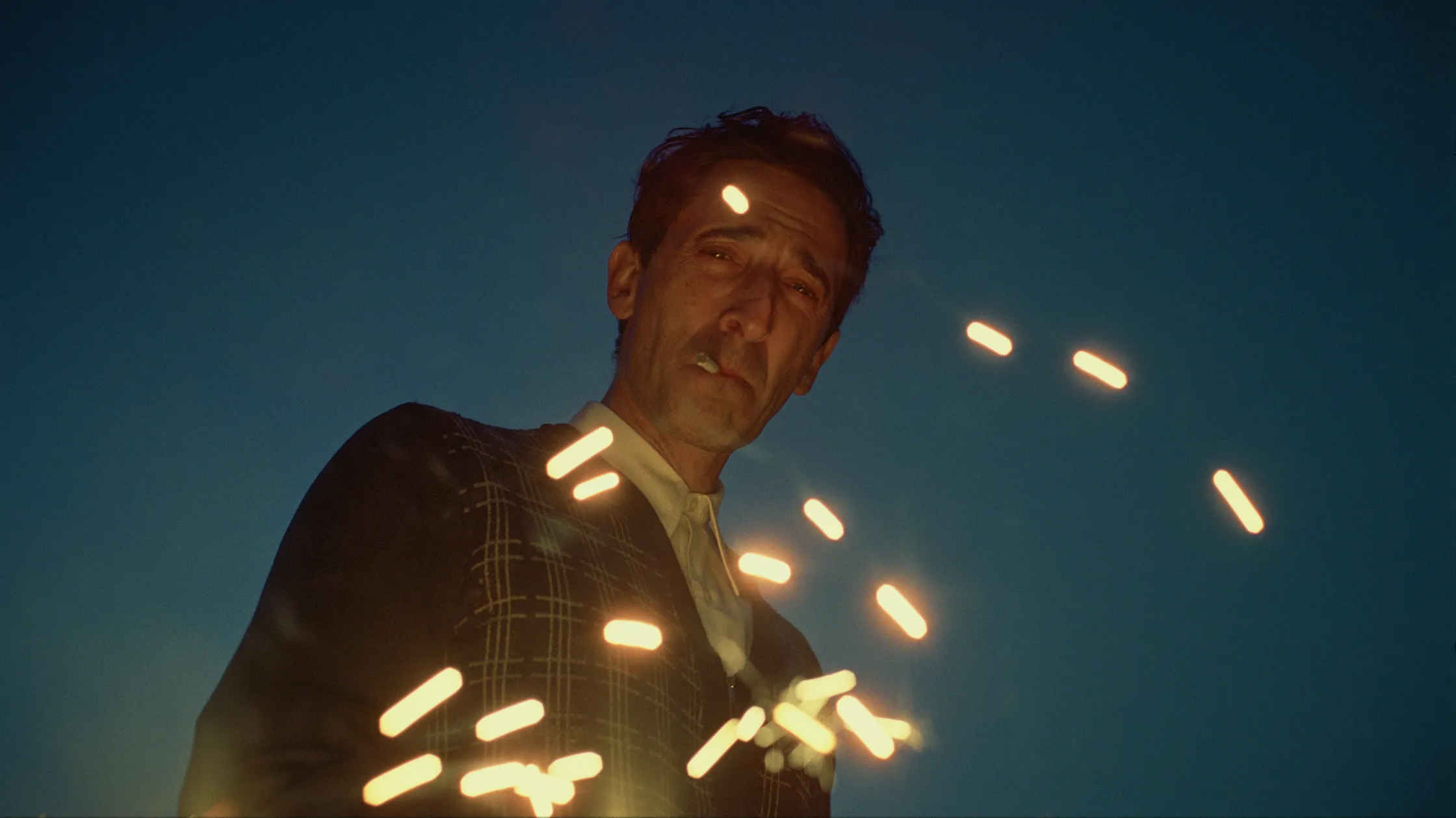“This place is rotten. The landscape, the food we eat. This whole country is rotten.”
Brady Corbet’s 2024 epic follows the life of László Tóth, a visionary architect finding his way in post-World War II America. The massive 215-minute film aims to depict a multitude of themes throughout its runtime, including the immigrant experience, the effects of war, the struggles of assimilation and even a broad argument against the hypocrisy of America’s past, present and possibly future. The film stars Adrien Brody as Tóth, a Hungarian-Jewish architect and Holocaust survivor who immigrates to the United States in 1947 with his wife, Erzsébet (Felicity Jones), to rebuild their lives and pursue the American Dream. The long-pursued American Dream has given hope to generations upon generations of individuals, not just in the United States, and it’s those seeking out its rewards that are seen to pay a costly debt.
Part 1: The Enigma of Arrival
The first half of the film focuses on Tóth’s experiences with the cold and vast nature of modernist architecture. Almost reflective of our protagonist, the impersonal nature of brutalist architecture becomes a part of his character. When he is forced into isolation, beyond the enduring of Nazi concentration camps, it is easy to understand the traumatic effects it could have – and has – left on individuals. This part still manages to paint Tóth as an idealist, someone who manages to believe in the human good and pursues the highest form of good in his art, architecture. The film explores this psychological burden of his past and contrasts it with his attempts to reconcile his family from war-torn Europe while balancing a life in America. It’s clear that Tóth remains optimistic throughout this journey, but a clear shift in his character happens as the film progresses. However, Tóth is an immigrant through and through, and this experience mirrors that of so many others who struggle to find a place. From living in the closet of his family to ultimately being kicked out, Tóth is tested over and over again with the hopes of rebuilding and reinventing himself away from Europe.
The dream of the Americas carries over to the art of Tóth. He’s overly idealistic, and his modernist ideas soon clash with traditionalist post-war America. The first cracks appear in his idealism when he struggles to find commissions. In one particularly telling scene, a wealthy developer sneers at his European aesthetic, dismissing his work as “too severe” for an American audience obsessed with ornamentation and status. He continues to sacrifice and put aside his beliefs for money – for survival.
The introduction of Harrison Lee Van Buren (Guy Pearce) offers what is essentially the American Dream to Tóth: an opportunity to construct a structure to last centuries. Van Buren, while not a particularly smart man, is able to recognize the brilliance of Tóth and offers him the commission. This is the first step into Tóth’s transformation; this is the moment to look back upon as his character becomes corrupted. His naïveté leads Tóth astray – toward all the mistakes a first-time, newly-commissioned architect with all the freedom in the world is given. Van Buren’s patronage is not purely altruistic, but Tóth convinces himself otherwise in pursuit of art. The obsessed artist has been portrayed many times over (exceptionally well in films like Damien Chazelle’s “Whiplash” or Darren Aronofsky’s “Black Swan”), but there’s so little emphasis placed on Tóth’s transition that it almost gets swept under the rug. Brody’s subtle but incredible acting places the audience at ease that Tóth remains the bright-eyed character that set foot in New York, unaware that he has crossed a threshold he may never return back to.
Part 2: The Hard Core of Beauty
The first half, while having hints of pessimism, is ultimately about hope and ambition; the second half of the film is the slow erosion of artistic vision under capitalism. We see the foundations of Tóth’s grand work – the huge concrete structures of permanence and everlasting – but underneath, throughout the construction, much compromise has to be made under the financial and legal stresses placed upon Tóth. What was once just a small compromise becomes a series of events that leads Tóth’s work to feel foreign. His original artistic vision and grand design slowly become a string of compromises that leave the splendid to be simply empty. Architecture’s democratic purpose and intention becomes a place of consumerism and tools for corporate and governmental identities to instill their beliefs.
Tóth achieves everything he once dreamed of – wealth, recognition, a seat at the table of America’s cultural elite. And yet, the more he builds, the less he recognizes himself. His marriage suffers. Erzsébet watches as the man she once loved, the man who spoke of art as a force for good, becomes another cog in the machine. The distance that builds between the two isn’t merely the effect of an artist placed at the edge – while true, is not the only reason – but also symbolic of Tóth’s own estrangement of his own work. His work becomes co-opted by those whose beliefs differ from his; the graffiti-covered walls of Tóth’s magnum opus stands as a haunting image of the mirage that is the American Dream – the dream he once chased, alienating him from himself and his family.
“The Brutalist” is not just any historical drama. It does not focus on a time period but aims to dissect the American Dream. Through this character of László Tóth, the film explores the American Dream, the immigrant experience and the illusion of artistic autonomy under these pretenses. The film leaves the audiences with the unsettling truth that the world is built upon capital, not talent.
—
Feature Image via A24

